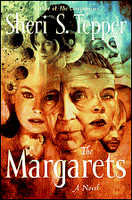 Sherri Tepper is a prolific writer of both science fiction and fantasy. Her latest novel is an ambitious work the is for-the-most-part a success. The Margarets takes place far in the future. Margaret is a twelve-year old girl living on Mars’ moon Phobos with her parents. Terrans have for the most part destroyed the Earth through overpopulation and much of the population has abandoned the planet for colonies on other worlds. However interstellar races who advanced earlier than Earthians have been keeping an eye on them. There is some indecision as to whether or not the human race should be allowed to continue to exist.
Sherri Tepper is a prolific writer of both science fiction and fantasy. Her latest novel is an ambitious work the is for-the-most-part a success. The Margarets takes place far in the future. Margaret is a twelve-year old girl living on Mars’ moon Phobos with her parents. Terrans have for the most part destroyed the Earth through overpopulation and much of the population has abandoned the planet for colonies on other worlds. However interstellar races who advanced earlier than Earthians have been keeping an eye on them. There is some indecision as to whether or not the human race should be allowed to continue to exist.
Some of the races who sit in judgment of humanity are benevolent, while others are vile, living only for torture, pain and cruelty. The former have set in motion a plan to prove that Earthians are worthy, and in the process, give them a gift to help them mature as a race. Central to this plan in young Margaret. As a child, Margaret invented six different aspects of herself, imaginary playmates, to keep loneliness at bay as the only child on the colony. There was Wilvia, the Queen; Naumi, the warrior; a spy, a healer and more. When Margaret and her parents are sent back to earth, and then several years later, when Margaret is forced to leave the planet forever, her other selves are lost to her. Yet in reality, and unveknownst to Margaret, each of her six other selves follow a different path and flourish on different colonies, some finding great hardship and pain, while others have families and find love.
In the end, Margaret must bring all her selves together to help save the human race, with the help of some pretty remarkable beings created out of Tepper’s incredibly fertile imagination. The dozens of races and beings Tepper creates in The Margarets is impressive, and there is very little that seems tired or familiar. My main complaint comes with such a large cast and massive landscape that some areas seem glossed over or too quickly resolved. Already clocking in at just over 500 pages, The Margarets could have used a couple hundred more to truly explore Tepper’s ideas.
